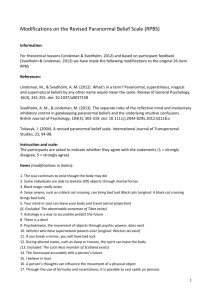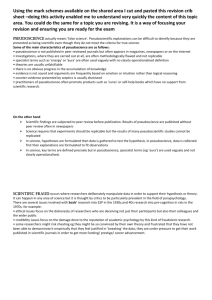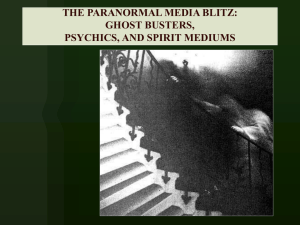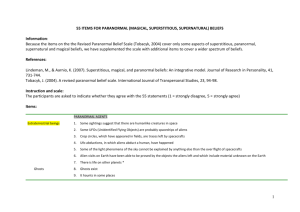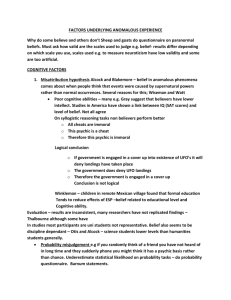File - the Durham School Psychology Department!
advertisement
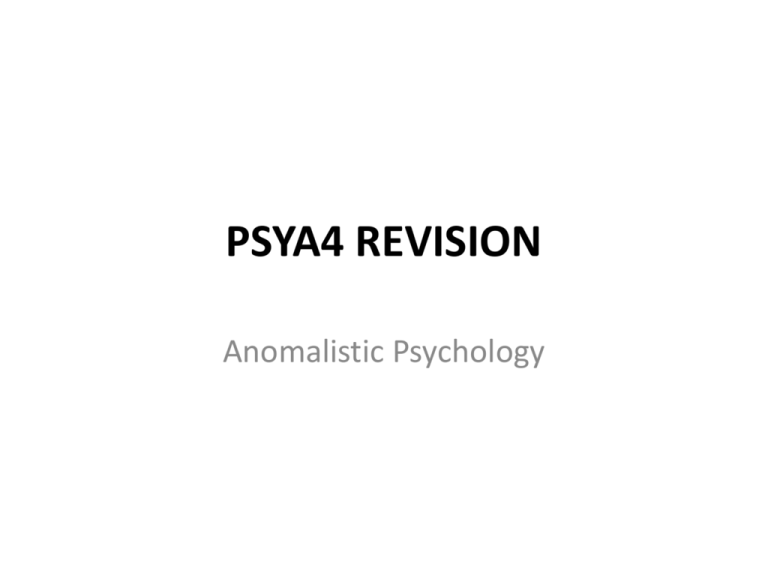
PSYA4 REVISION Anomalistic Psychology Syllabus Anomalistic Psychology The Study of Anomalous Experience •Pseudoscience and the scientific status of parapsychology •Methodological issues related to the study of paranormal cognition (ESP, inc. Ganzfeld) •Methodological issues related to the study of paranormal action (PK) Explanations for anomalous experiences •The role of coincidence and probability judgements in anomalous experiences • Explanations for superstitious behaviour and magical thinking • Personality factors underlying anomalous experience Research into exceptional experience • Psychological research into and explanations for * psychic healing, * near death and out of body experiences, * psychic mediumship FEATURES of a SCIENCE and a PSEUDOSCIENCE SCIENCE PSEUDOSCIENCE • Clearly OPERATIONALISED terms are used which are objective do not allow for BIAS • • Research is analysed and scrutinised by experts (PEER REVIEW) before being reported in reputable journals Vague, Specialist terms are used which have no clear operationalisation, increasing the opportunity for bias and SUBJECTIVITY. This also makes it difficult to replicate research to check the validity of findings • A lack of adequate scrutiny of research (no peer review) with findings are reported directly to the public via the open access internet sites • Theories/hypotheses are developed to ‘fit’ research findings. Theories are often never revised, even in the light of failed research. Negative results are suppressed which puts a bias on positive results which support theories (FILE DRAWER EFFECT) • • Theories allow for the generation of FALSIFIABLE hypotheses which are then investigated using controlled, OBJECTIVE, EMPIRICAL methods. Hypotheses and theories are revised in light of research findings Findings and research can be REPLICATED (i.e. they are reliable) to ensure accuracy Is Parapsychology a Science or Pseudoscience (the ‘scientific status’ of parapsychology) PSEUDOSCIENCE because… • Many concepts are abstract, unfalsifiable, poorly operationalised and do not adhere to the law of parsimony. Theories are not rejected even in the light of contradictory research – • Much of the research lacks adequate controls and standardisation. Specialist terms with no objective definition are often used which makes research difficult to replicate and prone to bias – • E.g… E.g. of research which lacks control? Standardisation? The way the results and theories are communicated lacks scientific rigour as there is often no peer review and results are communicated directly to the public with no academic scrutiny, e.g. using open access journals or public websites SCIENCE because… • Some of the research and theories have scientific aspects. Some research is highly controlled and uses objective methods and standardised procedures which eliminate the possibility of bias and fraud – E.G autoganzfeld procedure Outline how parapsychologists have investigated ESP (paranormal cognition) ZENER CARDS GANZFELD (must know this) • Sender and Receiver • 5 symbols • Sender ‘sends’ image; receiver has to say which image is being sent • HIT is when the receiver gets the image right! • Above 25% accuracy is evidence of ESP • Could mention the later (more controlled) versions • Sender and Receiver in separate rooms • Sender selects a target image randomly from four • Receiver in a room with red lights, has ping pong balls over eyes and white noise played (say why) • Sender ‘sends’ image • Receiver free associates, which involves… • Receiver then presented with the four possible images and judges which image was being sent Methodological Issues with ESP Research (e.g. ‘discuss issues with the study of paranormal cognition’) • SECURITY ISSUES – ESP studies influenced by a lack of adequate controls. – PPTS may be given the target images by fraudulent means (e.g…) – However, these issues were overcome by… – Positive ESP results cannot be replicated, especially under controlled conditions, suggesting fraud – BUT THIS MAY BE DUE TO PSI-BLOCKAGE… • INADEQUATE RANDOMISATION OF TARGET IMAGES Outline how parapsychologists have investigated PK (paranormal action) CASE STUDIES of individuals with the abilities DICE THROWING / REGS (MUCH BETTER – use these!) • RHINE – Participants asked to influence the roll of a dice – HIT rate above 1 in 6 = evidence of PK. Radin found reported this • Electronic version (e.g. SCHMIDT) – asked participants to influence the falling of a electronic coin [heads or tails]. – Randomisation achieved on the basis of decay of radioactive particles – Found evidence for PK as participants were more successful than what would be expected by chance alone. Methodological Issues with PK Research (e.g. ‘discuss issues with the study of paranormal cognition’) • SECURITY ISSUES – PK apparatus may be BIASED so may not reflect actual PK ability (how do we achieve this?) – Lots of examples of fraud from the case studies (e.g…) – Positive PK results cannot be replicated, especially under CONTROLLED conditions, suggesting fraud – BUT THIS MAY BE DUE TO PSI-BLOCKAGE… • Problems with SELECTIVE ANALYSIS and SELECTIVE REPORTING Role of Coincidence and Probability • Basically, you have to be able to explain why people who believe (sheep) are more likely to attribute strange/weird/unexpected occurrences to the paranormal and not to simple coincidence (the ‘misattribution hypothesis’) • Likely to be STIMULUS DRIVEN Role of Coincidence and Probability Believers misunderstand probability (MUST KNOW) – Believers do not understand probability because they underestimate the fact that every event has a possibility of occurring BY CHANCE – They do not understand the law of truly large numbers – This makes them more likely to think a strange coincidence has a paranormal explanations as they cannot understand the logic of probability! – This could be underpinned by a poor general cognitive ability and a lack of logical thought (indicated by poor performance on syllogistic reasoning tasks) OTHER reasons why believers do not simply think ‘coincidence’ – Believers do not understand the gamblers fallacy – Selective memories (von restorff effect) – Subjective validation and the ego centric bias – They create illusions of connection NOTE the evaluation and research for this in your workbook Superstitions and Magical Thinking MUST BE ABLE TO DEFINE SUPERSTITION • A SUBJECTIVE belief that one act/event affects another, even though there is no logical relationship between the two (Kida, 2006) MAGICAL THINKING • When people attribute special powers or properties to certain objects EXPLANATIONS - Superstitions BEHAVIOURAL (learning) • Classical Conditioning – Superstition becomes associated with a positive outcome • Operant conditioning – Superstition is followed by a positive consequence (positive reinforcement) – Superstition removes anxiety associated with an event (negative reinforcement) – Punishment occurs if a person does not do a superstition and something negative happens – SKINNERS PIGEONS • SOCIAL LEARNING – Observe and imitate the superstitions of models – Vicarious reinforcement, characteristics of models COGNITIVE • Superstitions provide an illusion of control over an event which is difficult to predict and control (e.g. sport, exam) • Superstitions may have a placebo effect • Selective memories and other cognitive biases (e.g. ego centric bias) may reinforce the superstition EXPLANATIONS Magical Thinking COGNITIVE • Law of contagion: some people believe objects retain the essence / power of things / people they were associated with • Because of this, a person believes the object may provide / lead to the same outcome for them! • Could also apply the ideas from before (illusion of control, placebo effect, etc) BEHAVIOURAL • As before, just applied differently The role of PERSONALITY in anomalous beliefs • Here, explain what personality characteristics have been linked with paranormal beliefs • Be specific to specific beliefs if you can • Explain WHY the personality types lead to belief in the paranormal • Again, likely to stimulus driven but this ‘lends’ itself more to a ‘classic’ essay question The role of PERSONALITY in anomalous beliefs EXTROVERSION EXTERNAL LOCUS OF CONTROL • Linked to ESP belief • Extroversion is associated with characteristics such as sociability, sensation seeking, impulsivity, recklessness and optimism. • Research seems to suggest that extroversion is associated with paranormal beliefs, especially ESP (HONORTON (1998) • Extroverts are more likely to believe in the paranormal because a belief in the paranormal may satisfy an extroverts need for sensation and may make the person the centre of attention • Linked to superstitions and magical thinking and ESP (IRWIN 1986) • People with an ELOC believe that circumstances and events are controlled by factors outside of themselves (external factors) such as ‘luck’, ‘fate’ or ‘the paranormal’, The role of PERSONALITY in anomalous beliefs • OTHER PERSONALITY FACTORS LINKED TO PARANORMAL BELIEF – Sensation seeking – Neuroticism (may provide escapism) – Creativity and Fantasy Proneness EXCEPTIONAL EXPERIENCES • You must be able to discuss AT LEAST TWO STUDIES into – – – – PSYCHIC HEALING PSYCHIC MEDIUMSHIP OUT OF BODY EXPERIENCES NEAR DEATH EXPERIENCES Likely to be asked together; if not, research can be applied to both at a push • You should be able to DEFINE each term • In the CONCLUSIONS of the studies, include EXPLANATIONS • Essays = 4+6 (e.g. ‘discuss what research has shown about…’) Psychic Healing Keller and Bzdek EVALUATION • • • • • • • Investigated therapeutic touch on tension headaches (assessed via a standardised test) Volunteer sample (adverts) PPTS assigned to either TT or non TT condition; single blind employed In the TT condition, a healer used TT; in the non TT condition, nothing happened PPTS reported immediately after if the pain had decreased 90% said they experienced a reduction in pain, significantly higher than in the control (non TT group) THIS SHOWS TT is a genuine ability which can lead to a reduction of pain. This explained by the idea that psychic healers possess a special kind of PK ability which allows them to stimulate a persons immune system which leads to healing • • • • Use of a single blind is an advantage as this eliminates placebo effects (or does it?) Independent measures design used so we cannot be sure individual differences didn’t play a role (perhaps those in the TT condition just happened to have headaches which naturally subsided during the study) Sample issues – Volunteer sample so… (smash this – Believers likely to respond!); also only tested effect of psychic healing on tension headaches so we cannot be sure psychic healing doesn’t work for other problems Operationalisation of ‘improvement’ – Questionnaire / interview may be prone to social desirability and investigator effects / demand characteristics Long term effects? Psychic Healing LYVERS EVALUATION • • Use of a double blind is an advantage (eliminates expectancy / placebo effects in the PPTS and possible bias in researchers) • Some questions about the operationalisation of improvement • Sample issues (Small, volunteer, only tested one type of ailment so…) Investigated psychic healing can help back pain • Volunteer sample (advert in an Australian newspaper) • PPTS assigned to either a healing or non healing condition • Double blind employed (researchers recording results ALSO didn’t know which condition was which) • Results = no significant difference between the two groups. BUT did find a POSITIVE CORRELATION between belief in psychic healing and reported reduction of pain (regardless of the condition they were in) THIS SHOWS psychic healing is not a genuine ability and that any positive effects can be explained through psychological factors (e.g. placebo effects or expectancy effects) Psychic Mediumship BEISCHEL and SCHWARTZ EVALUATION • • Use of a triple blind is a major methodological advantage as it eliminates investigator bias and other demand characteristics. It also eliminates the notion of fraud • Limited sample – only eight mediums used, so this does not mean ALL mediums are genuine • Why did they have trial runs? • Poor operationalisation of accuracy; it is unclear how the researcher defined an accurate reading. This may not stand up to scrutiny and lowers the validity of conclusions • • • Eight university students (‘sitters’) and 8 mediums Triple blind employed – No one had any information about anyone or anything else! A number of trial runs took place before the mediums gave their readings The accuracy of the readings was assessed by the sitters as ‘very high’ THIS SHOWS that mediumship is a genuine ability and can be explained by the idea that some people have a special kind of psi ability that allows them to communicate with the dead, see into the future or conduct telepathy Psychic Mediumship O’KEEFE and WISEMAN EVALUATION • • Use of a triple blind study is an advantage because… • Poor operationalisation of accuracy – readings judged on a scale (ordinal data) which may be a problem as it is difficult to define / understand what each point is worth • Sample issues… • There is a possibility that negative results were due to Psi Blockage. However, according to the law of parsimony… • • • Study in response to Beischel and Schwartz Five mediums gave a reading to five sitters The sitters read ALL readings and rated each one with relation to how relevant it was to them. Overall, the ratings given by sitters were the LOWEST for the readings about them! THIS SHOWS mediumship IS NOT a genuine ability. It indicates that any success in psych mediumships can be attributed to clever FRAUD, including techniques such as hot and cold reading, the use of Barnum statements, fishing, pregnant pauses, etc… OBEs and NDEs ANECDOTAL EVIDENCE of OBEs RING - NDE • • Mrs Z – was able to read a number which was placed in another room • Maria and the sneaker – When in hospital, Maria was able to give details about a sneaker which was on top of a cabinet in another room. This could not be seen from Maria’s room Both studies suggest people can have OBEs. This supports the ideas of DUALISM (the body and soul / conscience are separate and can become disconnected EVALUATION • Case studies so… • Other non paranormal explanations are more likely and parsimonious – – Mrs Z: FRAUD. She may have gotten the info via sensory leakage from researchers Maria: Investigations proved that she COULD actually see the sneaker from her room. Also, she may have heard nurses talking about it (NB. She may not have remembered this however due to the drugs she was on) Conducted interviews with people who reported having an NDE • Established the CORE FEATURES of an NDE (moving towards a light, meeting loved ones, feelings of euphoria, etc) • Later research identified CULTURE SPECIFIC elements too This suggests NDEs are a genuine paranormal experiences due to the unlikely fact that people report very similar accounts. Also supports the notion of DUALISM… EVALUATION • Problems with interviews (bias, social desirability, etc) so reports may lack validity • Sample issues – cannot apply the results to everyone (cannot say ALL NDEs have the same features) OBEs and NDEs RESEARCH INTO BIOLOGICAL BASIS PERSINGER EVALUATION • • A scientific, objective, empirical study… • Ethical but Sample issues… • Problems with the ecological validity – was Persinger’s actually a genuine OBE/NDE? Arguably not as it wasn’t as intense as other reported OBEs/NDEs • Incomplete to suggest ALL OBEs/NDEs are a result of abnormal activity in the TPJ as some people report having OBEs/NDEs but have normal neurological activity • Was supported/validated however by BLANKE… Wanted to investigate the idea that abnormality in the temporal parietal junction may lead to OBEs/NDEs (note the TPJ is responsible for integrating environmental info, making the self-other distinction and monitoring/controlling visual, auditory and somatosensory systems). • Used transcranial magnetic stimulation to artificially stimulate the TPJ • Reported that he experienced OBE / NDE like experiences THIS SHOWS that OBEs/NDEs are not a paranormal phenomena and are instead a result of abnormal neurological activity OBEs and NDEs • You may have used other research – Anoxia (lack of oxygen) and Hypercarbia (high CO2 in the bloodstream) • e.g. often experienced by fighter pilots who often report OBE / NDE like experiences, suggesting that anoxia / hypercarbia are the cause of OBEs/NDEs – Raised GLUTAMATE levels • e.g. as a result of drug [e.g. Ketamine] use; this is often accompanied by OBE / NDE type experiences, suggesting that raised glutamate causes the experiences • All studies suggest that OBEs / NDEs have a BIOLOGICAL BASIS • Remember to evaluate; stick to the classics!
